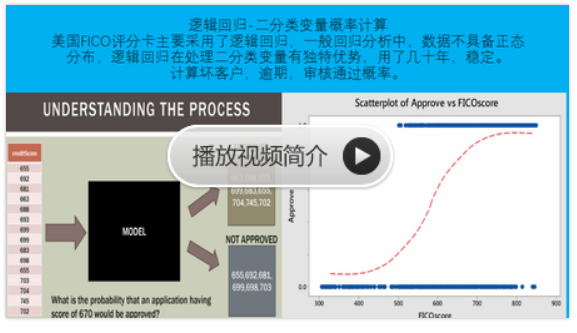How-to: Do Statistical Analysis with Impala and R
sklearn实战-乳腺癌细胞数据挖掘(博客主亲自录制视频教程)
https://study.163.com/course/introduction.htm?courseId=1005269003&utm_campaign=commission&utm_source=cp-400000000398149&utm_medium=share

http://blog.cloudera.com/blog/2013/12/how-to-do-statistical-analysis-with-impala-and-r/
The new RImpala package brings the speed and interactivity of Impala to queries from R.
Our thanks to Austin Chungath, Sachin Sudarshana, and Vikas Raguttahalli of Mu Sigma, a Decision Sciences and Big Data analytics company, for the guest post below.
As is well known, Apache Hadoop traditionally relies on the MapReduce paradigm for parallel processing, which is an excellent programming model for batch-oriented workloads. But when ad hoc, interactive querying is required, the batch model fails to meet performance expectations due to its inherent latency.
To overcome this drawback, Cloudera introduced Cloudera Impala, the open source distributed SQL query engine for Hadoop data. Impala brings the necessary speed to queries that were otherwise not interactive when executed by the batch Apache Hive engine; Hive queries that used to take minutes can be executed in a matter of seconds using Impala.
Impala is quite exciting for us at Mu Sigma because existing Hive queries can run interactively with few or no changes. Furthermore, because we do a lot of our statistical computing on R, the popular open source statistical computing language, we considered it worthwhile to bring the speed of Impala to R.
To meet that goal, we have created a new R package, RImpala, which connects Impala to R. RImpala enables querying the data residing in HDFS and Apache HBase from R, which can be further processed as an R object using R functions. RImpala is now available for download from the Comprehensive R Archive Network (CRAN) under GNU General Public License (GPL3).
The RImpala architecture is simple: we used the existing Impala JDBC drivers and wrote a Java program to connect and query Impala, which we then called from R using the rJava package. We put them all together in an R package that you can use to easily query Impala from R.

Steps for Installing RImpala
Assuming that you have R and Impala already installed, installing the RImpala package is straightforward and is done in a manner similar to any other R package. There are two steps to installing RImpala and getting it working:
Step 1: Install the package from CRAN
You can install RImpala directly using the install.packages() command in R.
|
1
|
> install.packages("RImpala")
|
Alternatively, if you need to do offline installation of the package, you can download it from here and install using the R CMD INSTALL command:
|
1
|
R CMD install RImpala_0.1.1.tar.gz
|
Step 2: Install the Impala JDBC drivers
You need to install Cloudera’s JDBC drivers before you can use the RImpala package that we installed earlier. Cloudera provides JBDC jars on its website that you can download directly. As of this writing, this is the link to zip file containing the JDBC jars.
There are two ways to do this:
- If you have Impala installed on the machine running R, then you will have the necessary JDBC jars already (probably in /usr/lib/impala/lib) and you can use them to initiate the connection to Impala.
- If the machine running R is a different server than the Impala server, then you need to download the JDBC jars from the above link and extract it to a location that can be accessed by the R user.
After you have installed the JDBC drivers you can start using the RImpala package:
- Load the library.
1library(RImpala)
- Initialize the JDBC jars.
1rimpala.init("/path/to/impala/jars")
- Connect to Impala.
1rimpala.connect("IP or Hostname of Impala server", "port")
The following is an Rscript showing how to connect to Impala:
123library(RImpala)rimpala.init(libs="/tmp/impala/jars/")rimpala.connect("192.168.10.1","21050")Location of JDBC jars = /tmp/impala/jars
IP of the server running impalad service = 192.168.10.1
Port where the impalad service is listening = 21050
The default parameter for the rimpala.init() function is “/usr/lib/impala/lib” and the default parameters for rimpala.connect() function are “localhost” and “21050” respectively.
To run a query on the impalad instance that the client has connected, you can use the rimpala.query() function. Example:
|
1
|
result
|
All the contents of the sample_table will be stored in the result object as a data frame. This data frame can now be used for further analytical processing in R.
You can also install the RImpala package on a client machine running Microsoft Windows. Since the JDBC jars are platform independent, you can extract them into a folder on a Windows machine (such as “C:\Program Files\impala”) and then this location can be passed as a parameter to the rimpala.init() function.
The following a simple example that shows you how to use RImpala:
|
1
2
3
4
5
6
7
8
9
10
11
12
13
14
15
16
17
18
19
20
21
22
23
24
25
26
27
28
29
30
31
32
33
34
35
36
37
38
39
40
41
42
43
44
45
46
47
48
49
50
51
52
53
54
|
> library(RImpala)
Loading required package: rJava
> rimpala.init(libs="/tmp/impala/jars/") # Adds the impala JDBC jars present in the "/tmp/impala/jars/" folder to the classpath
[1] "Classpath added successfully"
> rimpala.connect(IP="192.168.10.1",port="21050") # Establishes a connection to impalad instance running on the machine 172.25.1.151 on the port 21050
[1] TRUE
> rimpala.invalidate() # Invalidates the metadata of all the tables present in the Hive metastore
[1] TRUE
> rimpala.showdatabases()# Displays all the databases available
# Output #
name
1 airlines
2 bank
3 default
> rimpala.usedatabase("bank") # Changes the current database to "bank"
Database changed to bank
[1] TRUE
> rimpala.showtables() # Displays all the tables present in the current database
# Output #
name
1 bank_web_clicks
2 ticker_100m
3 stock_1gb
4 weblog_10gb
> rimpala.describe("bank_web_clicks") # Describes the table "bank_web_clicks"
# Output #
Name type comment
1 customer_id int Customer ID
2 session_id int Session ID
3 page string Web page name
4 datestamp timestamp Date
> result result
# Output #
customer_id session_id cnt
1 32 21 5200
2 34 12 5100
3 35 49 4105
4 32 34 3600
5 36 32 3218
6 37 67 3190
7 31 45 2990
8 35 75 2300
9 34 69 2113
> rimpala.close() # Closes the connection to the impalad instance
[1] TRUE
|
Conclusion
Impala is an exciting new technology that is gaining popularity and will probably grow to be an enterprise asset in the Hadoop world. We hope that RImpala will be a fruitful package for all Big Data analysts to leverage the power of Impala from R.
Impala is an ongoing and thriving effort at Cloudera and will continue to evolve with richer functionality and improved performance – and so will RImpala. We will continue to improve the package over time and incorporate new features into RImpala as and when they are made available in Impala.
Austin Chungath is a Senior Research Analyst with Mu Sigma’s Innovation & Development Team and maintainer of the RImpala project. He does research on various tools in the Hadoop ecosystem and the possibilities that they bring for analytics. He spends his free time contributing to Open Source projects like Apache Tez or building small robots.
Sachin Sudarshana is a Research Analyst with Mu Sigma’s Innovation & Development Team. His responsibilities include researching emerging tools in the Hadoop ecosystem and how they can be leveraged in an analytics context.
Vikas Raguttahalli is a Research Lead with Mu Sigma’s Innovation & Development Team. He is responsible for working with client delivery teams and helping clients institutionalize Big Data within their organizations, as well as researching new and upcoming Big Data tools. His expertise includes R, MapReduce, Hive, Pig, Mahout and the wider Hadoop ecosystem.
python风控评分卡建模和风控常识(博客主亲自录制视频教程)
How-to: Do Statistical Analysis with Impala and R的更多相关文章
- [Python] Statistical analysis of time series
Global Statistics: Common seen methods as such 1. Mean 2. Median 3. Standard deviation: the larger ...
- survival analysis 生存分析与R 语言示例 入门篇
原创博客,未经允许,不得转载. 生存分析,survival analysis,顾名思义是用来研究个体的存活概率与时间的关系.例如研究病人感染了病毒后,多长时间会死亡:工作的机器多长时间会发生崩溃等. ...
- Why many EEG researchers choose only midline electrodes for data analysis EEG分析为何多用中轴线电极
Source: Research gate Stafford Michahial EEG is a very low frequency.. and literature will give us t ...
- Methods for follow-up research of exome analysis:外显子后续分析研究思路总结
外显子后续分析研究思路一般有以下几种(Methods for follow-up research of exome analysis): 1.对突变频率.突变类型.突变方式进行统计分析 Mutati ...
- MAST 397B: Introduction to Statistical Computing
MAST 397B: Introduction to Statistical ComputingABSTRACTNotes: (i) This project can be done in group ...
- PayPal高级工程总监:读完这100篇论文 就能成大数据高手(附论文下载)
100 open source Big Data architecture papers for data professionals. 读完这100篇论文 就能成大数据高手 作者 白宁超 2016年 ...
- 100 open source Big Data architecture papers for data professionals
zhuan :https://www.linkedin.com/pulse/100-open-source-big-data-architecture-papers-anil-madan Big Da ...
- 一些我推荐的和想上的网络课程(Coursera, edX, Udacity)
从面向找工作的角度出发,我觉得以下课程有很大帮助: 首推Robert Sedgewick,也是我觉得对我帮助最大的老师,讲课特点是能把复杂的算法讲解清楚(典型例子:红黑树,KMP算法) 他在Cours ...
- 斯坦福CS课程列表
http://exploredegrees.stanford.edu/coursedescriptions/cs/ CS 101. Introduction to Computing Principl ...
随机推荐
- Nginx 如何通过连接池处理网络请求
L:35-36 worker_connections 默认 512个 这个链接需要设置的 worker_cpu_affinity 0001 0010 0100 1000;关联CPU connecti ...
- Nginx proxy_protocol协议
L:113
- Nginx 缓存深入理解
100课陶辉 proxy_cache_methods 指令主要是根据请求方法指定是否使用缓存 Syntax: proxy_cache_methods GET | HEAD | POST ...; De ...
- Android 模块化/热修复/插件化 框架选用
概念汇总 动态加载:在程序运行的时候,加载一些程序自身原本不存在的文件并运行这些文件里的代码逻辑.动态加载是热修复与插件化实现的基础. 热修复:修改部分代码,不用重新发包,在用户不知情的情况下,给ap ...
- 了解AutoCAD对象层次结构 —— 2 ——文档
再次想象另外一个场景:启动AutoCAD程序后,您新建了两个.dwg文件,也就是说创建了两个文档(Document)对象.将窗口进行层叠,您看到的窗口应该与下图类似: 图 4‑3 如何访问这些文档呢? ...
- JSON 解析 (二)—— Jackson的使用
Jackson是基于Java语言的一种JSON和Java对象的数据处理工具.功能上简单易用,性能上根据目前主流转换工具比较,Jackson相对比较高效. <dependency> < ...
- bzoj 2653: middle (主席树+二分)
2653: middle Time Limit: 20 Sec Memory Limit: 512 MBSubmit: 2522 Solved: 1434[Submit][Status][Disc ...
- 树莓派(Raspberry Pi)使用Shell编写的极简Service
树莓派(Raspberry Pi)运行的系统是基于Debian的,不仅可以运行Shell,还支持systemd和docker,可以编写一个简单的服务,让其在启动时运行,执行一些自动化的操作.这里在Ra ...
- 【dp】P1434 [SHOI2002]滑雪
题目描述 Michael喜欢滑雪.这并不奇怪,因为滑雪的确很刺激.可是为了获得速度,滑的区域必须向下倾斜,而且当你滑到坡底,你不得不再次走上坡或者等待升降机来载你.Michael想知道在一个区域中最长 ...
- 136.137.260. Single Number && 位运算
136. Single Number 意思就是给你一堆数,每个数都出现了两次,只有一个数只出现了一次,找出这个数 位运算(和c艹一样) &:按位与 |:按位或 ^:异或(一样为0,不一样为1) ...

